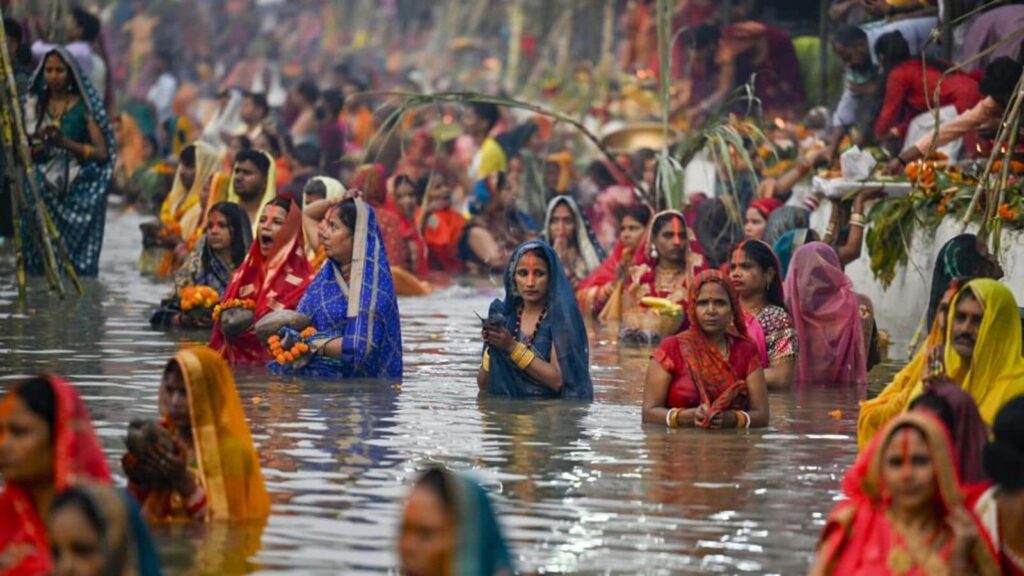Delhi: Devotees celebrate Chhath Puja at ‘ghats’ amid tougher norms | Latest News Delhi

Devotees across Delhi celebrated Chhath Puja on Thursday by submerging themselves in artificial “ghats”, as access to the river’s natural banks was barricaded a day after the Delhi high court refused to lift a 2021 ban imposed on immersions in the polluted river.

Chhath Puja, a four-day celebration observed by people from Bihar and eastern Uttar Pradesh, involves the offering of “arghya” by fasting devotees to the sun in knee-deep water on a designated day, which this year is November 7 and 8.
In 2021, the Delhi HC prohibited immersion in the Yamuna due to severe water pollution, and the court reinforced it again this year on Wednesday, with stricter implementation.
Roads and lanes leading to ghats were blocked, while officials were deployed to ensure that people were directed to the artificial ghats created nearby, officials familiar with the plan said. The Entry near major ghats along the Yamuna banks near Kalindi Kunj, ITO, Okhla and Nigam Bodh has been restricted since Wednesday.
In many areas, artificial ghats were created in the floodplains itself so that the devotees who came to the ghats had easy accessibility to familiar worship sites.
“In Gopalpur village in Timarpur, people used to offer prayers by stepping into the Yamuna till a few years ago. However, since that was not allowed, there were around 8-9 large pits dug up this year along the sandy floodplains that is hardly 200 metres from the river. People could reach easily and did not even have to change the venue that they go to every year for their prayers. Over 20,000 people visited the area on Thursday night,” said Amrendra Jha, one of the organisers of the Chhath Puja committee.
The Delhi Disaster Management Authority (DDMA) first imposed the ban in September 2021, though enforcement proved challenging as many devotees continued to visit Yamuna banks in defiance of the order in 2021 as well as in 2022.
To accommodate worshippers, the Delhi government established over 1,000 artificial ponds last year, and this year’s implementation was even stricter.
“Our family has celebrated Chhath Puja every year and we used to go to the Kalindi Kunj ghat before Covid. Since it was stopped a few years ago, we go to the artificial ghat near our village in Okhla. It was a bit chaotic last year, but this year was much better,” said Raju Yadav, one of the devotees, whose family lives in Okhla’s Taimoor Nagar.
While Delhi enforced a complete ban on riverbank festivities due to Yamuna’s toxic foam, celebrations proceeded just across the border in Noida. There, authorities organised a ghat near Kalindi Kunj with facilities, public announcements, traffic arrangements, and street vendors, a
Many residents from Delhi also crossed the Kalindi Kunj bridge to carry out immersions in the river instead of artificial ghats.
Just a few metres away from the devotees, who were surrounded by layers of toxic froth, Delhi Jal Board’s (DJB) boats were visible sprinkling anti-foaming solutions to counter the build-up of froth.
[NEEDS A LINE ON HERE ON WATER POLLUTION LEVELS AT KALINDI KUNJ TODAY.. GIVE CONTEXT ON HOW HIGH IT WAS COMPARED TO SAFE LEVELS]
Traffic officials said that hundreds of thousands of people visited the Kalindi Kunj Yamuna ghat on Thursday evening and took a dip in the river, taking advantage of the lax restrictions on the Noida side.
“We now go to Noida side every year as there is good arrangement along the riverbed and no restrictions on the devotees. It is just a few kilometres more for us. The festival is about taking a dip in the river and cannot mean the same thing if done at home or at a pond. The children also like going to the river,” said Annu Singh, a resident of Mayur Vihar who was at the Yamuna ghat with an extended family of over 50 people.
In Delhi, the Municipal Corporation of Delhi (MCD) also took preventive measures, fogging at 1,052 Chhath Puja sites and deploying anti-larval treatments.
Experts note that the toxic froth in Yamuna, visible each winter, reflects persistent high levels of untreated sewage and industrial waste in the river, with defoaming agents offering only a temporary reprieve. The annual phenomenon underscores the need for more sustained and effective pollution control efforts along Delhi’s waterways.




